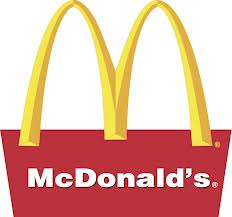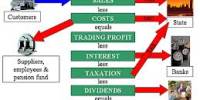Executive Summary
McDonald’s Corporation is a “Centralized, International company”, which competes in the fast food industry supplying hamburgers, french fries and other consumable items using standardization, heavy expansion and branding as the driving force. McDonald’s operates in over 121 countries and has over 30,000 restaurants worldwide.
McDonald’s utilized an intense, rapid expansion into foreign countries through three primary methods, franchising, company owned restaurants, and joint ventures. With the majority of international restaurants stemming from franchising agreements, McDonald’s management relied on this method to aid in the acceptance of a new style of eating into unfamiliar markets. With minimal risk and maximum gains, franchising continues to contribute heavily to McDonald’s international success.
With a centralized, international structure, McDonald’s keeps a tight grasp on operations, cost and quality. With an ethnocentric management strategy, McDonald’s relies on domestic based logic and attitudes and transfers them to their international outlets and restaurants.
In order to control its overseas operation, McDonald’s uses a combination of two approaches. The majority of control would fall under the rules approach, meaning that control lies with headquarters creating procedures and policies for the subsidiaries to follow. However, there is also a little of the cultural approach that has surfaced and is being utilized judging by the adaptation that has occurred in some of the overseas restaurants. This has occurred even with the tight internalized norms that are constantly presented and enforced by headquarters.
McDonald’s Background

With operations in over 121 countries and over 30,000 restaurants around the globe, McDonald’s Corporation is the largest fast food service and supplier in the world. To serve all of the their customers and demonstrate the incredible size of the company, McDonald’s has more than one and a half million employees and serves more than ninety-six percent of the world’s population at least once a year. McDonald’s operates in the fast food industry and its core product lines include hamburgers and french fries, but the chain also sells chicken, salads, and fish products among others.
Since the first restaurant operations in the early nineteen fifties, McDonald’s has grown at an incredible pace through an internal philosophy of “expand at all costs.” What this philosophy means is open as many stores as possible as fast as possible. At the peak of the company’s growth, this rapid pace had a new McDonald’s outlet opening every four hours everyday of the year. Management instilled the idea that as more restaurant locations are opened the more customers will be served, and this leads to higher profits that would be realized across the board. Since the beginning, this intense expansion plan has been successful, both in the domestic and foreign markets abroad. However, recently there have been issues developing with saturation across the globe that have had an impact on sales, which will be discussed later in the paper.
The company has always utilized four major principles throughout its history to expand rapidly, increase sales and remain the market leader. By leveraging their enormous cash flow, brand power, real estate and customer spending habits, McDonald’s has not only emerged as the world-wide leader, it has also changed the way the world eats. As the means to rapid expansion are not the focus of this paper, altering the eating habits around the world represent a very significant topic and will also be addressed later in the paper.
International Operations Significance
McDonald’s first international expansion occurred in 1967 when the company opened in Canada. The company’s international division was formed shortly after in 1969 and has continuously grown since. Over the years, the international section of the McDonald’s Corporation has become increasingly more important to the company’s overall success. As of this past year, non-US based restaurants account for over half of the company’s $40 billion in revenues (Appendix A). Even more critical than the amount of sales to the company is the amount of profits of the overseas operations. Foreign restaurants now account for about 60% of McDonald’s total profits4. The difference between revenues and profits of international operations is credited to McDonald’s immense market share in off shore outlets. Currently, McDonald’s is the market leader in 96% of the markets they do business in around the world and it is very common for McDonald’s to hold over 50% of the fast food market in foreign markets. Unlike the U.S., competitors in the past have not cut into McDonald’s market share as easily in foreign markets, although that is beginning to change.
There are a few major reasons why McDonald’s not only chose to invest overseas originally, but also continuously since. In the last ten years, almost 90% of McDonalds’ expansion occurred in countries other than the United States. During that time, the 1990’s saw an increase in international units from 3,600 in 1991 to more than 11,000 by 1998, largely in Japan, Canada, Germany, Great Britain, Australia, and France. Additionally, the number of international countries nearly doubled from 59 in 1991 to 114 in 1998 (Appendix B). The rationale behind these important decisions stemmed foremost from the increasing amount of saturation that had evolved in the United States. This saturation was in the past, and is currently, forcing McDonald’s to slash prices and as a result profits in its domestic market. To counter this trend, international restaurants were franchised and invested in. As was mentioned earlier, foreign markets are extremely more profitable for McDonald’s than U.S. operations. McDonald’s detected this trend early as an opportunity through marketing research and the idea of utilizing the heavily populated areas of focus to cut costs and increase profits. Second, expansion in the U.S. has been taking place for the last 45 years, where it has only been occurring heavily overseas for about 20 years, so there is more business opportunity. McDonald’s serves over 43 million people a day, but that is still less than one percent of the world’s population, so you can see how McDonald’s management could be so optimistic.
To reiterate the importance of McDonald’s international restaurants to the overall core business plan of McDonald’s, a closer look at a few facts is required. First, the busiest McDonald’s in the world is located in Pushkin Square in Moscow. The restaurant serves over 43,000 customers a day and is only one example of the volume that some of the larger foreign restaurants are capable of. In fact, eight of the ten largest McDonald’s outlets in the world are located outside of the United States.
International Expansion through Franchising
Now that the international operations have been conveyed as an increasingly important part of McDonald’s overall sales, it is vital to analyze how McDonald’s entered into the foreign markets. McDonald’s entered into the international markets utilizing three methods; franchising, joint ventures and company owned outlets. Where McDonald’s had a choice, franchising was not only favored, it dominated how the company expanded. Currently, 73% of all McDonald’s restaurants across the globe are franchised16. When entering into some of the countries, McDonald’s had to abandon its philosophy of franchising and use the other methods. For instance, when McDonald’s first entered into Mexico, the government did not allow franchising from foreign countries. To work around this, McDonald’s utilized company owned restaurants to enter the market until the laws changed. In 1990, when the legislation went through legalizing franchising, McDonald’s Corporation sold the company owned outlets to franchisees. Similarly, joint ventures were used as an early entry method where franchising was not feasible. Although this option was not McDonald’s first priority, it was not a far second behind franchising, and the company’s most prosperous international success to date stems from an initial joint venture in Japan.
To grasp a better understanding of how important franchising was to McDonald’s rapid international growth, the very concept of franchising must be analyzed. McDonald’s restaurants have crossed international borders fairly easily compared to other retail sectors and it is attributed directly to franchising. However, the idea of franchising was not a new one to McDonald’s. In fact, McDonald’s expansion in the United States began very early in the company’s first years utilizing a method that was relatively new to the industry, franchising5.
It was the fast food industry, and McDonald’s specifically, that turned franchising into a business model that would transform the retail economy of the world. At the heart of a franchise arrangement is the desire by two parties to make money while avoiding risk. The franchiser wants to expand an existing business without spending its own funds. The franchisee wants to run a business without going at it alone and risking everything on a new idea. One provides a brand name, a business plan, expertise, and access to equipment and supplies. The other puts up the money and does the work10. In the case of McDonald’s, they wanted an international presence without the incredible risk associated with entering foreign countries and altering eating habits. McDonald’s knew that entering into foreign markets would be very difficult for an American fast food company and needed the aid of local partners to ease the transition. That is exactly what franchising allowed McDonald’s to accomplish. By franchising, McDonald’s could be marketed as a local country business instead of an American company strong-arming their way in. What they had to offer was the fastest growing fast food business in the world. Not to mention an extensive supplier line, industry leading technology and a very prosperous business history for anyone willing to accept the terms and pay the franchising fees.
Administrative Heritage
When comparing and contrasting the past and present organizational history of McDonald’s, the reflection in a mirror becomes top of mind. McDonald’s is one of the world’s most insular large companies, with a management team more typical of a private company than a global powerhouse. The average top executive started working at the company when Richard Nixon was President and there are no future plans to shuffle top management. The 15-member board of directors has avoided the corporate-governance revolution that has attacked a large majority of the Fortune 500 companies. By adding directors who do not have a direct stake in the company, share holders, consumers, and employees can be reassured that actions made are for the good of the company. However, McDonald’s has elected not to take part in this trend. Currently, more than two thirds of the board of directors is filled with current and former executives, vendors, and service providers4.
McDonald’s has basically been the same for fifty years, and change does not seem to be a top priority. The company focus has always been publicly stated as being directed to McDonald’s customers and employees, although both have been debated extensively over the years. One topic that has remained constant throughout the company’s history is the emphasis on management training. Management centers are now located in Munich, Tokyo, Sydney and London where professors instruct management students in 22 languages. These centers are replicas of the Hamburger University that has become famous in the United States, not only for the information taught, but also for the large number of managers that have been trained at the facilities.
McDonald’s Structure and Strategy
McDonald’s is a “centralized, International Division” company composed of franchisees and joint venture partners. McDonald’s utilizes a broad approach and initially grew overseas by relying on transferring new products, processes, and strategies from the United States to less developed markets1. The idea has always been to transfer the American tradition of fast food to other counties using the same real estate principles, cost advantages, and new technologies that were so successful in the U.S. McDonald’s has always exploited the corporate company knowledge and transported and diffused it to foreign markets. Starting with the concrete supplier chain, all the way down to the store design and implementation, differentiation is not encouraged nor is it allowed.
With an Ethnocentric mentality, McDonald’s has constantly based the companies international operations on “home-grown” ideas and concepts. Corporate first places the focus the domestic market, and then filters the functions to the overseas operations. Information flows from corporate to the franchisees based on what is working in the United States markets, with the expectation that it will be implemented in the foreign markets. When analyzing McDonald’s corporate structure (Appendix C), it is evident that the top down approach is not only used it is enforced. All information starts with corporate and is disbursed to the foreign markets.
Company Control and Coordination
In order to control the thousands of franchises in the system, McDonald’s corporate utilizes a combination of methods. Both the Rules Approach and the Cultural Approach are applied by management in order to ensure that the international outlets maximize their potential without disrupting the overall corporate plan. The reason for the combination of control approaches stems from the nature of how the McDonald’s system was built. By relying and building around franchising, a fine line has to be drawn between keeping the franchises motivated and accomplishing the company objectives.
The elements of the Rules approach are very evident when magnifying the requirements of the franchisees. Management requires continuous lines of reports and paperwork to follow every move of the franchises. The extent of the requirements can be seen in the following example. The McDonald’s operation-and-training manual is a roughly seven hundred and fifty-page document that weighs about four pounds. It is known throughout the company as “the Bible” and contains precise instructions on how various appliances should be used, how each item on the menu should look, and how employees should greet the customers. An example of the extent of detail that is contained in the manual are hamburgers are always to be placed on the grill in six neat rows; french fries have to be exactly 0.28 inches thick. The regimentation and standardization of McDonald’s restaurants determines exactly how every task is done and imposes rules about pace, quality and technique. The McDonald’s Corporation insists that its operators follow directives on food preparation, purchasing, store design and countless other minute details. Operators who disobey these rules can lose their franchises and this has occurred in the past.
The control from corporate can be extensive at times and franchises are constantly threatened. “We have found out…that we cannot trust some people, who are nonconformists,” declared Ray Kroc, one of the founders of McDonald’s, angered by some of his franchisees. “We will make conformists out of them in a hurry…The organization cannot trust the individual; the individual must trust the organization…”4,10 From the beginning of time, McDonald’s management has created and pushed an operating system of unusual thoroughness and attention to detail. In order to enforce this style of management, McDonald’s has strategically placed local and regional offices throughout the world (Appendix D).
As mentioned before, the nature of franchising has led to this pattern of control and further discussion on the topic is warranted to clarify it. The franchising relationship has its built-in tensions. The franchiser gives up some control by not wholly owning each operation and the franchisee sacrifices a great deal of independence by obeying the company rules. Everyone is happy when the company is succeeding and profits are rolling in, but when revenues fall, the arrangement often degenerates into a mismatched battle for power. The franchiser almost always wins. In the global world of McDonald’s, that exact scenario is currently taking place. The last three years, McDonald’s has seen lagging sales in the domestic market and booming sales in the international markets. As a result, corporate is trying to tighten the reigns on foreign operations even tighter than they have in the past10. The key to a successful franchise, according to many texts on the subject, can be expressed in a single word: uniformity. Franchises must reliably offer the same product or service at numerous locations. This is the case with McDonald’s. They must continue to provide a high quality core product line at the lowest possible cost available. Customers are drawn to familiar brands by an instinct to avoid the unknown. A brand offers a feeling of reassurance when its products are always and everywhere the same. At the same time, a little control must be sacrificed to keep motivation and creativity among the franchises blossoming. This concept is why McDonald’s management also utilizes some of the Cultural Approach to control the international markets.
Through the years, McDonald’s management has realized that in the fast food industry, more freedom is needed in order to prosper in foreign countries. There are two major business functions that are dictated by the country’s local influence and symbolize the Cultural Approach freedom; product development and marketing. These functions are not only locally developed they are operational away from headquarters and are represented in McDonald’s structure chart accordingly (Appendix C). By allowing the foreign markets the autonomy to develop and market geographical specific menu items, management is not compromising or deviating from internalized company norms or standards. Instead, they are allowing for local adaptation that will not only benefit the franchise, but the corporation as well. Both product development and marketing will be discussed in detail below.
Product Development and Marketing
As mentioned previously, product development and marketing can and do occur at a local level in McDonald’s international countries. These are the only two major business functions that McDonald’s Corporate allows some flexibility by deviating from the tight grasp that they hold over international restaurants. Now, that is not to say that the countries and local markets have complete freedom to add to the menu and promote their products how they wish. McDonald’s prides itself in the consistency of its products and taste around the world and would not allow complete autonomy. Instead, it means that some of the lengthy, tedious, and idea crushing control that corporate normally holds over its franchises is lifted slightly and can occur at the country level as opposed to corporate level (Appendix C). To look at the impact this has on the international outlets, a closer look at product development and marketing will each be analyzed.
Each local country has the autonomy and authority to develop its own products to address unique tastes that their consumers have. It is the sole responsibility of the individual country to complete the marketing research and develop new menu items. Once that has occurred, the information is then studied and approved or rejected by the corporate offices depending on the extent of favorable data available. Where there is limited involvement from corporate in the development process, there is still heavy involvement in the acceptance process. This involvement from corporate is only increasing, as the international markets become more important to McDonald’s overall business. However, according to Den Fujita, President of McDonald’s Japan, when McDonald’s first entered Japan, corporate was relatively accommodating to the new menu items that were presented to them, and as a result, acceptance in Japan was expedited5.
There are many examples of item adjustments that have been made around the world over the years to address local tastes and preferences (Appendix E). The menu changes resulted from many different reasons such as cultural, religious, taste preferences and translation reasons. Some specific examples are in India, there are no beef items served throughout the country, so McDonald’s added the “Maharaja Mac”, a lamb version of the standard “Big Mac”. Other examples include Germany, where McDonald’s serves beer with meals and in Cyprus, the McNistisima menu was adopted for the lent period between Easter and Christmas and consisted of veggie burgers, country potatoes, and shrimp and spicy rolls14,16. Occasionally, new local menu items might not seem like a logical choice for a country and are protested accordingly like when McDonald’s was going to recently add meat bowls over rice. Heavy protesting occurred until the launch of the items. However, on the first day the bowls were available, they sold out entirely proving that local marketing research and flexibility can benefit the company13.
The marketing of international restaurants is handled with the same process as product development. Locally, the countries develop and test market ideas that differ from the corporate worldwide message. Any differences in the core message are then presented to the corporate office for approval. Marketing overseas, like product development, is mostly handled away from the corporate office. There are many reasons why the core marketing message would change, including; translation reasons, cultural differences, customer target differences and the fact that the product itself being marketed might not even exist in the company’s core message. A specific example of a country differing the marketing message from corporate took place in different countries that use the metric system. Instead of calling their burger the “Quarter Pounder”, the European countries market their burger as either the “Royal Hamburger” or the “Burger Royal.”
Future Issues for McDonald’s
In order for the international division of McDonald’s to continue the impressive success that it has achieved in the past, two major areas of concern must be addressed. The increasing level of saturation in most of the major markets around the world and the struggle over autonomy between corporate and the franchises must be addressed with extreme urgency and by allocating the resources necessary.
As mentioned earlier, competition in the fast food industry is becoming incredibly saturated. When McDonald’s first began expanding into international markets, their main focus was altering eating habits. This was primarily because there was an absence of major competitors overseas. However, over the last decade, the international market is beginning to mirror that of the heavily saturated United States market. Profits are shrinking, same store sales are down, and the overall market growth has slowed tremendously. This has prompted McDonald’s to continue to cut costs by announcing the closing of 175 under performing outlets in 10 countries. As the international markets become more competitive and saturated, McDonald’s must continue to analyze and make adjustments accordingly.
Although saturation is a growing issue overseas, it was noted earlier that foreign operations are now more than ever, a major element of the McDonald’s Corporation business. As a result there is a constant battle over autonomy. The franchises, especially the experienced outlets with over a decade of success, want more autonomy to adapt to local tastes and preferences. The franchises feel that as the market becomes more competitive, it will be vital for alterations and adaptations to occur faster and easier than they ever have in the past. However, McDonald’s corporate is on the opposite side of the issue and is not budging. Corporate feels that control must be at an all time high because of the importance of the international division and the fact that if it fails, the whole company could suffer as a result. Corporate has tightened the reigns consistently the last few years and will continue to do so to stay afloat by turning the losses into gains.
















